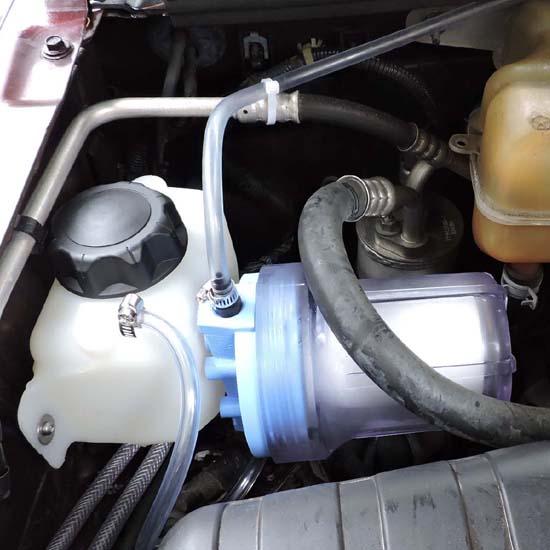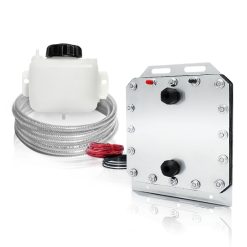No products in the cart.
Safety of hydrogen in vehicles
Better Fuel generators produce hydrogen “on-demand”.
The gas gets burnt in the engine the moment it is produced. It is never accumulated or stored and is perfectly safe. To ensure 100% safety, Better Fuel controllers shut down hydrogen production when the engine is not running.
Read more: How hydrogen generators for vehicles work
Compatibility of equipment
Better Fuel systems are designed to work in all types of vehicles.
The correct combination of a hydrogen generator and an electronic controller is required to achieve maximum fuel saving results.
- Select the generator appropriate for the size of your engine
- Use a ProTuner controller
Read more: How to select correct equipment
Hydrogen HHO in diesel applications
HHO works perfectly in diesel vehicles.
Gasoline engines consume excessive fuel, while diesel vehicles operate on an excess of air. These entirely different technologies require different approaches.
Better Fuel has developed unique solutions to effectively reduce fuel consumption on both types of engines.
Improvement in fuel economy
Automotive hydrogen supplementation has been well proven to improve horse power, increase fuel efficiency and reduce emissions.
Our controlled experiments with gasoline vehicles demonstrated 54% improvement in mileage. Diesel engines achieved 39%.
Results vary depending on application, the amount of hydrogen produced by the generator, quality of the installation and tuning
Safety of the engine
No damage is possible.
HHO protects the engine by lowering the temperature of the combustion.
The fuel is burned more cleanly and completely resulting in cleaner engine oil and less carbon build up in the combustion chamber; both contributing to an extended engine life
Read more: Results of NASA’ s experiments with hydrogen in internal combustion engines
Summary

Article Name
Operation and installation of hydrogen HHO generators for cars
Description
Better Fuel generators produce hydrogen “on-demand”.
The gas gets burnt in the engine the moment it is produced. It is never accumulated or stored and is perfectly safe. To ensure 100% safety, Better Fuel controllers shut down hydrogen production when the engine is not running.
HHO protects the engine by lowering the temperature of the combustion. The fuel is burned more cleanly and completely resulting in cleaner engine oil and less carbon build up in the combustion chamber; both contributing to an extended engine life.
Author
Better Fuel Technology
Publisher Name
Better Fuel Technology
Publisher Logo

Benefits of hydrogen HHO
- 25% to 54% improvement of fuel economy
- Significant reduction in emissions (CO, NOx)
- Prolonged engine life
- Greater torque and a smoother, stronger acceleration
- Increased engine power
- Cleaner oil due to reduced amount of carbon deposits in the engine
Read more: Effect of Hydrogen HHO on emissions
Read more: Results of NASA’ s experiments with hydrogen in internal combustion engines
Installation instructions
Professionally written installation instructions are provided in English, French, Spanish, Portuguese and Russian.
Our manuals offer step-by-step, easy to understand instructions with sections of more technical information for those who are interested.
Most customers do the installation without professional help
Summary

Article Name
Operation and installation of hydrogen HHO generators for cars
Description
Better Fuel generators produce hydrogen “on-demand”.
The gas gets burnt in the engine the moment it is produced. It is never accumulated or stored and is perfectly safe. To ensure 100% safety, Better Fuel controllers shut down hydrogen production when the engine is not running.
HHO protects the engine by lowering the temperature of the combustion. The fuel is burned more cleanly and completely resulting in cleaner engine oil and less carbon build up in the combustion chamber; both contributing to an extended engine life.
Author
Better Fuel Technology
Publisher Name
Better Fuel Technology
Publisher Logo

Installation location
Choose a mounting location away from engine heat with maximum air flow
The most common installation location for the generator is between the grill and the radiator.
Other options:
-Near the firewall and brake booster.
-If space is limited, look under the car and view the engine compartment from the underside. Many potential installation locations, that are not visible from the top, can be found here.
-If there are no other options, installation in the trunk of the car is acceptable, although the air circulation is limited and the generator may operate warmer than desired.
Useful links
Our recommendation for a good, low cost OBDII scan gauge to assist tuning for vehicle economy
Extensive list of service manuals for most vehicle makes and models.
These are the same comprehensive manuals that vehicle manufacturers provide to dealerships. They contain all possible information about your vehicle
Summary

Article Name
Operation and installation of hydrogen HHO generators for cars
Description
Better Fuel generators produce hydrogen “on-demand”.
The gas gets burnt in the engine the moment it is produced. It is never accumulated or stored and is perfectly safe. To ensure 100% safety, Better Fuel controllers shut down hydrogen production when the engine is not running.
HHO protects the engine by lowering the temperature of the combustion. The fuel is burned more cleanly and completely resulting in cleaner engine oil and less carbon build up in the combustion chamber; both contributing to an extended engine life.
Author
Better Fuel Technology
Publisher Name
Better Fuel Technology
Publisher Logo

Read more:
How to select correct equipment
How hydrogen generators for vehicles work
Engine carbon cleaning services vs hydrogen on demand generators
How to convert engines to use hydrogen as primary fuel
What happens when too much hydrogen is supplied to an engine
Results of NASA’ s experiments with hydrogen in internal combustion engines
Effect of Hydrogen HHO on Emissions
Visit our store
Summary

Article Name
Operation and installation of hydrogen HHO generators for cars
Description
Better Fuel generators produce hydrogen “on-demand”.
The gas gets burnt in the engine the moment it is produced. It is never accumulated or stored and is perfectly safe. To ensure 100% safety, Better Fuel controllers shut down hydrogen production when the engine is not running.
HHO protects the engine by lowering the temperature of the combustion. The fuel is burned more cleanly and completely resulting in cleaner engine oil and less carbon build up in the combustion chamber; both contributing to an extended engine life.
Author
Better Fuel Technology
Publisher Name
Better Fuel Technology
Publisher Logo








